
Baboon
Encyclopedia
Baboons are African and Arabian Old World monkey
s belonging to the genus Papio, part of the subfamily Cercopithecinae
. There are five species, which are some of the largest non-hominoid members of the primate
order; only the mandrill
and the drill
are larger. Previously, the closely related gelada
(genus Theropithecus) and the two species (mandrill and drill) of genus Mandrillus
were grouped in the same genus, and these Old World monkey
s are still often referred to as baboons in everyday speech. They range in size and weight depending on species. The Guinea baboon
is 50 cm (20 inches) and weighs only 14 kg (30 lb) while the largest chacma baboon
can be 120 cm (47 inches) and weigh 40 kg (90 lb).
, found in southern Africa), P. papio (western, red, or Guinea baboon
, found in the far western Africa), P. hamadryas (hamadryas baboon
, found in the Horn of Africa and south-western Arabia), P. anubis (olive baboon
, found in the north-central African savanna
) and P. cynocephalus (yellow baboon
, found in south-central and eastern Africa). Many authors distinguish P. hamadryas as a full species, but regard all the others as subspecies of P. cynocephalus and refer to them collectively as "savanna baboons". This may not be helpful: it is based on the argument that the hamadryas baboon is behaviorally and physically distinct from other baboon species, and that this reflects a separate evolutionary history. However, recent morphological and genetic studies of papio show the hamadryas baboon to be more closely related to the northern baboon species (the Guinea and olive baboons) than to the southern species (the yellow and chacma baboons).
The traditional 5-form classification probably under-represents the variation within Papio. Some commentators argue that at least two more forms should be recognized, including the very tiny Kinda baboon
(P. cynocephalus kindae) from Zambia, the DRC, and Angola, and the gray-footed baboon (P. ursinus griseipes) found in Zambia, Botswana, Zimbabwe, Mozambique, and northern South Africa. However, current knowledge of the morphological, genetic, and behavioral diversity within Papio is too poor to make any final, comprehensive judgment on this matter.

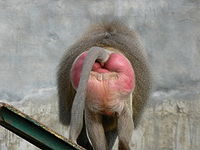 All baboons have long dog-like muzzles; heavy, powerful jaws with sharp canine teeth; close-set eyes; thick fur except on their muzzle; a short tail; and rough spots on their protruding buttocks
All baboons have long dog-like muzzles; heavy, powerful jaws with sharp canine teeth; close-set eyes; thick fur except on their muzzle; a short tail; and rough spots on their protruding buttocks
, called ischial callosities
. These callus
es are nerveless, hairless pads of skin that provide for the sitting comfort of the baboon.
In all baboon species there is pronounced sexual dimorphism
, usually in size but also sometimes in colour or canine development. Males of the Hamadryas Baboon species also have a large white mane.
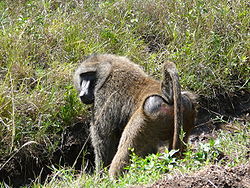 Baboons are terrestrial
Baboons are terrestrial
(ground dwelling) and are found in open savannah, open woodland and hills across Africa. Their diet is omnivorous
, but mostly vegetarian
; yet they eat insects and occasionally prey on fish, shellfish
, hares, birds, vervet monkey
s, and small antelopes. They are foragers and are active at irregular times throughout the day and night. They can raid human dwellings and in South Africa they have been known to prey on sheep and goats.
Their principal predators are human
s, the lion
, both the spotted
and striped hyena
and the leopard
. They are however considered a difficult prey for the leopard, which is mostly a threat to young baboons. Large males will often confront them by flashing their eyelids, showing their teeth by yawning, making gestures, and chasing after the intruder/predator.
Baboons in captivity have been known to live up to 45 years, while in the wild their life expectancy is about 30 years.
 Most baboons live in hierarchical troops. Group sizes
Most baboons live in hierarchical troops. Group sizes
vary between 5 to 250 animals (often about 50 or so), depending on specific circumstances, especially species and time of year. The structure within the troop varies considerably between hamadryas baboons and the remaining species, sometimes collectively referred to as savanna baboons. The hamadryas baboon often appear in very large groups composed of many smaller harems (one male with four or so females), to which females from elsewhere in the troop are recruited while they're still too young to breed. Other baboon species have a more promiscuous structure with a strict dominance hierarchy based on the matriline. The hamadryas baboon group will typically include a younger male, but he will not attempt to mate with the females unless the older male is removed.
Baboons can determine from vocal exchanges what the dominance
relations are between individuals. When a confrontation occurs between different families or where a lower-ranking baboon takes the offensive, baboons show more interest in the exchange than exchanges between members of the same family or when a higher-ranking baboon takes the offensive. This is because confrontations between different families or rank challenges can have a wider impact on the whole troop than an internal conflict in a family or a baboon reinforcing its dominance.
The collective noun for baboons is commonly troop or congress, although flange is also increasingly used. This unusual term originates from a Not the Nine O'Clock News
comedy sketch entitled "Gerald The Intelligent Gorilla" where it was used for comic effect.
In the harems of the hamadryas baboons, the males jealously guard their females, to the point of grabbing and biting the females when they wander too far away. Despite this, some males will raid harems for females. In such situations it often comes to aggressive fights by the males. Visual threats are usually accompanied by these aggressive fights. This would include a quick flashing of the eyelids accompanied by a yawn to show off the teeth. Some males succeed in taking a female from another's harem. This is called a "takeover". In many species, infant baboons are taken by the males as hostages during fights.
Baboons have also been known to incorporate dogs into their social groups.
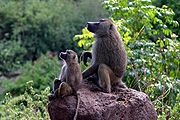
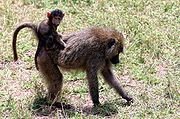 Baboon mating behavior varies greatly depending on the social structure of the troop. In the mixed groups of savanna baboons, each male can mate with any female. The mating order among the males depends partially on their social ranking, and fights between males are not unusual.
Baboon mating behavior varies greatly depending on the social structure of the troop. In the mixed groups of savanna baboons, each male can mate with any female. The mating order among the males depends partially on their social ranking, and fights between males are not unusual.
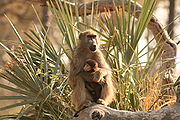 There are however more subtle possibilities; in mixed groups males sometimes try to win the friendship of females. To garner this friendship, they may help groom the female, help care for her young, or supply them with food. The probability is high that those young are their offspring. Some females clearly prefer such friendly males as mates. However, males will also take infants during fights in order to protect themselves from harm.
There are however more subtle possibilities; in mixed groups males sometimes try to win the friendship of females. To garner this friendship, they may help groom the female, help care for her young, or supply them with food. The probability is high that those young are their offspring. Some females clearly prefer such friendly males as mates. However, males will also take infants during fights in order to protect themselves from harm.
A female initiates mating by presenting her swollen rump to the male. But "presenting" can also be used as a submissive gesture and is observed in males as well. This submissive gesture has many unspoken meanings amongst the troop. The dominant males often engage in what is known as a false-mount, in which they mount the submissive males. It is a sign of dominance, and happens very commonly to younger males in the troop.
Females typically give birth every other year, usually to a single infant, after a six month gestation. The young baboon weighs approximately one kilogram and has a black epidermis when born. The females tend to be the primary caretaker of the young, although several females will share the duties for all of their offspring.
After about one year, the young animals are weaned. They reach sexual maturity in five to eight years. Baboon males leave their birth group, usually before they reach sexual maturity, whereas females are philopatric
and stay in the same group their whole life.
, Babi
was the deification of the hamadryas baboon and was therefore a sacred animal. It was known as the attendant of Thoth
and so is also called the Sacred Baboon.
Old World monkey
The Old World monkeys or Cercopithecidae are a group of primates, falling in the superfamily Cercopithecoidea in the clade Catarrhini. The Old World monkeys are native to Africa and Asia today, inhabiting a range of environments from tropical rain forest to savanna, shrubland and mountainous...
s belonging to the genus Papio, part of the subfamily Cercopithecinae
Cercopithecinae
The Cercopithecinae are a subfamily of the Old World monkeys, that includes in its roughly 71 species the baboons, the macaques and the vervet monkeys...
. There are five species, which are some of the largest non-hominoid members of the primate
Primate
A primate is a mammal of the order Primates , which contains prosimians and simians. Primates arose from ancestors that lived in the trees of tropical forests; many primate characteristics represent adaptations to life in this challenging three-dimensional environment...
order; only the mandrill
Mandrill
The mandrill is a primate of the Old World monkey family, closely related to the baboons and even more closely to the drill. Both the mandrill and the drill were once classified as baboons in genus Papio, but recent research has determined they should be separated into their own genus, Mandrillus...
and the drill
Drill (mammal)
The Drill is a primate of the family Cercopithecidae , closely related to the Baboons and even more closely to the Mandrill.-Description:...
are larger. Previously, the closely related gelada
Gelada
The gelada , sometimes called the gelada baboon, is a species of Old World monkey found only in the Ethiopian Highlands, with large populations in the Semien Mountains...
(genus Theropithecus) and the two species (mandrill and drill) of genus Mandrillus
Mandrillus
Mandrillus is the genus of the mandrill and its close relative the drill. These two species are closely related to the baboons, and until recently were lumped together as a single species of baboon. Both Mandrillus species have long furrows on either side of their elongated snouts. The adult male...
were grouped in the same genus, and these Old World monkey
Old World monkey
The Old World monkeys or Cercopithecidae are a group of primates, falling in the superfamily Cercopithecoidea in the clade Catarrhini. The Old World monkeys are native to Africa and Asia today, inhabiting a range of environments from tropical rain forest to savanna, shrubland and mountainous...
s are still often referred to as baboons in everyday speech. They range in size and weight depending on species. The Guinea baboon
Guinea Baboon
The Guinea baboon is a baboon from the Old World monkey family. Some classifications list only two species in the genus Papio, this one and the Hamadryas baboon. In those classifications, all other Papio species are considered subspecies of P...
is 50 cm (20 inches) and weighs only 14 kg (30 lb) while the largest chacma baboon
Chacma Baboon
The Chacma baboon , also known as the Cape baboon, is, like all other baboons, from the Old World monkey family. With a body length of up to 115 cm and a weight from 15 to 31 kg, it is among the largest and heaviest baboon species. The Chacma is generally dark brown to gray in color,...
can be 120 cm (47 inches) and weigh 40 kg (90 lb).
Classification and taxonomy
Five species of papio are commonly recognized, although there is some disagreement about whether they are really full species or subspecies. They are P. ursinus (chacma baboonChacma Baboon
The Chacma baboon , also known as the Cape baboon, is, like all other baboons, from the Old World monkey family. With a body length of up to 115 cm and a weight from 15 to 31 kg, it is among the largest and heaviest baboon species. The Chacma is generally dark brown to gray in color,...
, found in southern Africa), P. papio (western, red, or Guinea baboon
Guinea Baboon
The Guinea baboon is a baboon from the Old World monkey family. Some classifications list only two species in the genus Papio, this one and the Hamadryas baboon. In those classifications, all other Papio species are considered subspecies of P...
, found in the far western Africa), P. hamadryas (hamadryas baboon
Hamadryas Baboon
The Hamadryas baboon is a species of baboon from the Old World monkey family. It is the northernmost of all the baboons; being native to the Horn of Africa and the southwestern tip of the Arabian Peninsula. These regions provide habitats with the advantage for this species of fewer natural...
, found in the Horn of Africa and south-western Arabia), P. anubis (olive baboon
Olive Baboon
The olive baboon , also called the Anubis baboon, is a member of the family Cercopithecidae . The species is the most widely spread of all baboons: it is found in 25 countries throughout Africa, extending south from Mali to Ethiopia and to Tanzania. Isolated populations are also found in some...
, found in the north-central African savanna
Savanna
A savanna, or savannah, is a grassland ecosystem characterized by the trees being sufficiently small or widely spaced so that the canopy does not close. The open canopy allows sufficient light to reach the ground to support an unbroken herbaceous layer consisting primarily of C4 grasses.Some...
) and P. cynocephalus (yellow baboon
Yellow Baboon
The yellow baboon is a baboon from the Old World monkey family.Cynocephalus literally means "dog-head" in Greek due to the shape of its muzzle and head. It has a slim body with long arms and legs and a yellowish-brown hair. It resembles the Chacma baboon but is smaller and its muzzle is not as...
, found in south-central and eastern Africa). Many authors distinguish P. hamadryas as a full species, but regard all the others as subspecies of P. cynocephalus and refer to them collectively as "savanna baboons". This may not be helpful: it is based on the argument that the hamadryas baboon is behaviorally and physically distinct from other baboon species, and that this reflects a separate evolutionary history. However, recent morphological and genetic studies of papio show the hamadryas baboon to be more closely related to the northern baboon species (the Guinea and olive baboons) than to the southern species (the yellow and chacma baboons).
The traditional 5-form classification probably under-represents the variation within Papio. Some commentators argue that at least two more forms should be recognized, including the very tiny Kinda baboon
Kinda Baboon
The Kinda baboon is a subspecies of baboon present in the Miombo woodlands of Angola, the Democratic Republic of the Congo, Zambia, and possibly western Tanzania. While the Kinda Baboon is often considered to be a subspecies of the yellow baboon , it is distinct enough to merit status as full...
(P. cynocephalus kindae) from Zambia, the DRC, and Angola, and the gray-footed baboon (P. ursinus griseipes) found in Zambia, Botswana, Zimbabwe, Mozambique, and northern South Africa. However, current knowledge of the morphological, genetic, and behavioral diversity within Papio is too poor to make any final, comprehensive judgment on this matter.
Classification
There are 5 species of baboons in the genus Papio:- Genus Papio
- Hamadryas baboonHamadryas BaboonThe Hamadryas baboon is a species of baboon from the Old World monkey family. It is the northernmost of all the baboons; being native to the Horn of Africa and the southwestern tip of the Arabian Peninsula. These regions provide habitats with the advantage for this species of fewer natural...
, Papio hamadryas - Guinea baboonGuinea BaboonThe Guinea baboon is a baboon from the Old World monkey family. Some classifications list only two species in the genus Papio, this one and the Hamadryas baboon. In those classifications, all other Papio species are considered subspecies of P...
, Papio papio - Olive baboonOlive BaboonThe olive baboon , also called the Anubis baboon, is a member of the family Cercopithecidae . The species is the most widely spread of all baboons: it is found in 25 countries throughout Africa, extending south from Mali to Ethiopia and to Tanzania. Isolated populations are also found in some...
, Papio anubis - Yellow baboonYellow BaboonThe yellow baboon is a baboon from the Old World monkey family.Cynocephalus literally means "dog-head" in Greek due to the shape of its muzzle and head. It has a slim body with long arms and legs and a yellowish-brown hair. It resembles the Chacma baboon but is smaller and its muzzle is not as...
, Papio cynocephalus- Central yellow baboon, Papio cynocephalus cynocephalus
- Ibean baboon, Papio cynocephalus ibeanus
- Kinda baboonKinda BaboonThe Kinda baboon is a subspecies of baboon present in the Miombo woodlands of Angola, the Democratic Republic of the Congo, Zambia, and possibly western Tanzania. While the Kinda Baboon is often considered to be a subspecies of the yellow baboon , it is distinct enough to merit status as full...
, Papio cynocephalus kindae
- Chacma baboonChacma BaboonThe Chacma baboon , also known as the Cape baboon, is, like all other baboons, from the Old World monkey family. With a body length of up to 115 cm and a weight from 15 to 31 kg, it is among the largest and heaviest baboon species. The Chacma is generally dark brown to gray in color,...
, Papio ursinus- Cape chacma, Papio ursinus ursinus
- Gray-footed chacma, Papio ursinus griseipes
- Ruacana chacma, Papio ursinus raucana
- Hamadryas baboon
Anatomy and physiology


Buttocks
The buttocks are two rounded portions of the anatomy, located on the posterior of the pelvic region of apes and humans, and many other bipeds or quadrupeds, and comprise a layer of fat superimposed on the gluteus maximus and gluteus medius muscles. Physiologically, the buttocks enable weight to...
, called ischial callosities
Callosity
A callosity is another name for callus, a piece of skin that has become thickened as a result of repeated contact and friction.- Monkeys :When occurring on an animal's buttocks, as with baboons, they are specifically called ischial callosities...
. These callus
Callus
A callus is an especially toughened area of skin which has become relatively thick and hard in response to repeated friction, pressure, or other irritation. Rubbing that is too frequent or forceful will cause blisters rather than allow calluses to form. Since repeated contact is required, calluses...
es are nerveless, hairless pads of skin that provide for the sitting comfort of the baboon.
In all baboon species there is pronounced sexual dimorphism
Sexual dimorphism
Sexual dimorphism is a phenotypic difference between males and females of the same species. Examples of such differences include differences in morphology, ornamentation, and behavior.-Examples:-Ornamentation / coloration:...
, usually in size but also sometimes in colour or canine development. Males of the Hamadryas Baboon species also have a large white mane.
Behavior

Terrestrial animal
Terrestrial animals are animals that live predominantly or entirely on land , as compared with aquatic animals, which live predominantly or entirely in the water , or amphibians, which rely on a combination of aquatic and terrestrial habitats...
(ground dwelling) and are found in open savannah, open woodland and hills across Africa. Their diet is omnivorous
Omnivore
Omnivores are species that eat both plants and animals as their primary food source...
, but mostly vegetarian
Herbivore
Herbivores are organisms that are anatomically and physiologically adapted to eat plant-based foods. Herbivory is a form of consumption in which an organism principally eats autotrophs such as plants, algae and photosynthesizing bacteria. More generally, organisms that feed on autotrophs in...
; yet they eat insects and occasionally prey on fish, shellfish
Shellfish
Shellfish is a culinary and fisheries term for exoskeleton-bearing aquatic invertebrates used as food, including various species of molluscs, crustaceans, and echinoderms. Although most kinds of shellfish are harvested from saltwater environments, some kinds are found only in freshwater...
, hares, birds, vervet monkey
Vervet Monkey
The vervet monkey , or simply vervet, is an Old World monkey of the family Cercopithecidae native to Africa. The term "vervet" is also used to refer to all the members of the genus Chlorocebus....
s, and small antelopes. They are foragers and are active at irregular times throughout the day and night. They can raid human dwellings and in South Africa they have been known to prey on sheep and goats.
Their principal predators are human
Human
Humans are the only living species in the Homo genus...
s, the lion
Lion
The lion is one of the four big cats in the genus Panthera, and a member of the family Felidae. With some males exceeding 250 kg in weight, it is the second-largest living cat after the tiger...
, both the spotted
Spotted Hyena
The spotted hyena also known as laughing hyena, is a carnivorous mammal of the family Hyaenidae, of which it is the largest extant member. Though the species' prehistoric range included Eurasia extending from Atlantic Europe to China, it now only occurs in all of Africa south of the Sahara save...
and striped hyena
Striped Hyena
The Striped Hyena is a species of true hyena native to North and East Africa, the Caucasus, the Middle East, Middle and Central Asia and the Indian Subcontinent...
and the leopard
Leopard
The leopard , Panthera pardus, is a member of the Felidae family and the smallest of the four "big cats" in the genus Panthera, the other three being the tiger, lion, and jaguar. The leopard was once distributed across eastern and southern Asia and Africa, from Siberia to South Africa, but its...
. They are however considered a difficult prey for the leopard, which is mostly a threat to young baboons. Large males will often confront them by flashing their eyelids, showing their teeth by yawning, making gestures, and chasing after the intruder/predator.
Baboons in captivity have been known to live up to 45 years, while in the wild their life expectancy is about 30 years.
Social systems

Group size measures
Many animals, including humans, tend to live in groups, herds, flocks, bands, packs, shoals, or colonies of conspecific individuals. The size of these groups, as expressed by the number of participant individuals, is an important aspect of their social environment...
vary between 5 to 250 animals (often about 50 or so), depending on specific circumstances, especially species and time of year. The structure within the troop varies considerably between hamadryas baboons and the remaining species, sometimes collectively referred to as savanna baboons. The hamadryas baboon often appear in very large groups composed of many smaller harems (one male with four or so females), to which females from elsewhere in the troop are recruited while they're still too young to breed. Other baboon species have a more promiscuous structure with a strict dominance hierarchy based on the matriline. The hamadryas baboon group will typically include a younger male, but he will not attempt to mate with the females unless the older male is removed.
Baboons can determine from vocal exchanges what the dominance
Dominance (ecology)
Ecological dominance is the degree to which a species is more numerous than its competitors in an ecological community, or makes up more of the biomass...
relations are between individuals. When a confrontation occurs between different families or where a lower-ranking baboon takes the offensive, baboons show more interest in the exchange than exchanges between members of the same family or when a higher-ranking baboon takes the offensive. This is because confrontations between different families or rank challenges can have a wider impact on the whole troop than an internal conflict in a family or a baboon reinforcing its dominance.
The collective noun for baboons is commonly troop or congress, although flange is also increasingly used. This unusual term originates from a Not the Nine O'Clock News
Not the Nine O'Clock News
Not the Nine O'Clock News is a television comedy sketch show which was broadcast on BBC 2 from 1979 to 1982.Originally shown as a comedy "alternative" to the BBC Nine O'Clock News on BBC 1, it featured satirical sketches on current news stories and popular culture, as well as parody songs, comedy...
comedy sketch entitled "Gerald The Intelligent Gorilla" where it was used for comic effect.
In the harems of the hamadryas baboons, the males jealously guard their females, to the point of grabbing and biting the females when they wander too far away. Despite this, some males will raid harems for females. In such situations it often comes to aggressive fights by the males. Visual threats are usually accompanied by these aggressive fights. This would include a quick flashing of the eyelids accompanied by a yawn to show off the teeth. Some males succeed in taking a female from another's harem. This is called a "takeover". In many species, infant baboons are taken by the males as hostages during fights.
Baboons have also been known to incorporate dogs into their social groups.
Mating and birth



A female initiates mating by presenting her swollen rump to the male. But "presenting" can also be used as a submissive gesture and is observed in males as well. This submissive gesture has many unspoken meanings amongst the troop. The dominant males often engage in what is known as a false-mount, in which they mount the submissive males. It is a sign of dominance, and happens very commonly to younger males in the troop.
Females typically give birth every other year, usually to a single infant, after a six month gestation. The young baboon weighs approximately one kilogram and has a black epidermis when born. The females tend to be the primary caretaker of the young, although several females will share the duties for all of their offspring.
After about one year, the young animals are weaned. They reach sexual maturity in five to eight years. Baboon males leave their birth group, usually before they reach sexual maturity, whereas females are philopatric
Philopatry
Broadly, philopatry is the behaviour of remaining in, or returning to, an individual's birthplace. More specifically, in ecology philopatry is the behaviour of elder offspring sharing the parental burden in the upbringing of their siblings, a classic example of kin selection...
and stay in the same group their whole life.
Relationship with humans
In Egyptian mythologyEgyptian mythology
Ancient Egyptian religion was a complex system of polytheistic beliefs and rituals which were an integral part of ancient Egyptian society. It centered on the Egyptians' interaction with a multitude of deities who were believed to be present in, and in control of, the forces and elements of nature...
, Babi
Babi (mythology)
In Egyptian mythology, Babi, also Baba, was the deification of the baboon, one of the animals present in Egypt. His name is usually translated as Bull of the baboons, and roughly means Alpha male of all baboons, i.e. chief of the baboons...
was the deification of the hamadryas baboon and was therefore a sacred animal. It was known as the attendant of Thoth
Thoth
Thoth was considered one of the more important deities of the Egyptian pantheon. In art, he was often depicted as a man with the head of an ibis or a baboon, animals sacred to him. His feminine counterpart was Seshat...
and so is also called the Sacred Baboon.
See also
- List of historical monkeys
- ParapapioParapapioParapapio is a genus of prehistoric baboons closely resembling the forest dwelling mangabeys. Parapapio is distinguished from other Papio by the lack of an anteorbital drop, thin browridges, absence of maxillary fossae or a sagittal crest and only slight sexual dimorphism.There are four recognized...
- Amboseli Baboon Research ProjectAmboseli Baboon Research ProjectThe Amboseli Baboon Project is a long-term, coordinated series of studies of yellow baboons in the Amboseli basin of southern Kenya. It is based in the Amboseli National Park and southwestern parts of the Amboseli ecosystem, with its primary research camp based at Ologului Public Campsite...
Further reading
- Cheney, Dorothy L. / Seyfarth, Robert M. (2007): Baboon Metaphysics: The Evolution of a Social Mind. Chicago.
External links
- papio.com Informative website regarding Papio
- Baboons: Wildlife summary from the African Wildlife Foundation
- Primate Info Net Papio Factsheets
- Stress and Coping What baboons can teach us Lecture by Robert SapolskyRobert SapolskyRobert Maurice Sapolsky is an American scientist and author. He is currently Professor of Biological Sciences, and Professor of Neurology and Neurological Sciences and, by courtesy, Neurosurgery, at Stanford University. In addition, he is a Research Associate at the National Museums of...
at Stanford UniversityStanford UniversityThe Leland Stanford Junior University, commonly referred to as Stanford University or Stanford, is a private research university on an campus located near Palo Alto, California. It is situated in the northwestern Santa Clara Valley on the San Francisco Peninsula, approximately northwest of San...
(via iTunes) - BaboonsOnline.com
- Baboons wading through water bipedally
- Baboons of Saudi Arabia: Splendid Arabia, An Online Guide to the Kingdom of Saudi Arabia
- Webcam of the Baboon enclosure at Knowsley Safari Park

